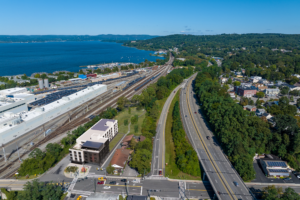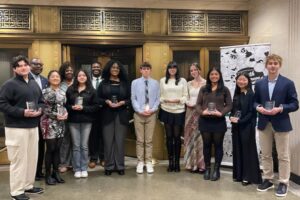 Village of Sleepy Hollow officials and residents will gather to kickoff a year of events commemorating the 150th Anniversary of Sleepy Hollow with a pumpkin drop, music and brief remarks on January 2 and 6:00pm. A 150th Anniversary Committee, led by Deputy Mayor Denise Scaglione, Trustee Patrick Sheeran and Recreation Superintendent Matthew Arone will announce some of the monthly activities that honor the history of the village and celebrate all those that have called Sleepy Hollow home.
Village of Sleepy Hollow officials and residents will gather to kickoff a year of events commemorating the 150th Anniversary of Sleepy Hollow with a pumpkin drop, music and brief remarks on January 2 and 6:00pm. A 150th Anniversary Committee, led by Deputy Mayor Denise Scaglione, Trustee Patrick Sheeran and Recreation Superintendent Matthew Arone will announce some of the monthly activities that honor the history of the village and celebrate all those that have called Sleepy Hollow home.
“On May 20, 1874, a group of concerned citizens created our local government. Each time when we meet to address the mutual needs of a community that has grown to over 12,000, we uphold the commitment that they made,” said Sleepy Hollow Mayor Martin Rutyna. “Thanks to the planning and dedication of subsequent generations, Sleepy Hollow has become an ideal place to live, raise a family, open a business, explore historic sites and experience natural beauty. Thanks to all those who continue to make the Village of Sleepy Hollow a welcoming place. If you haven’t been here for our world famous Halloween celebrations, our year-long 150th Anniversary events and inaugural Sleepy Hollow Music Festival in June make this the best year to visit Sleepy Hollow,” Mayor Rutyna continued.
Details of events, that are subject to change, will be made available on the Sleepy Hollow 150th Anniversary page on the village’s website.
Current plans include:
- Winter skating in the Village Hall parking lot on Beekman Ave., February 10,
- 150th Anniversary themed St. Patrick’s Day Parade, March 9
- Commemorative planting of 150 trees in April, Time Capsule planting
- Car Show celebrating Sleepy Hollow’s automotive history, May 18
- Inaugural Sleepy Hollow Music Festival, June 8
- Commemorative 150th Anniversary fireworks in July 4th
- Sleepy Hollow Carnival, August
- 150th Anniversary Block Party, September
- 150th themed Halloween Hayride, October
- Pumpkin Chunkin, November
- 150th Anniversary themed winter stroll, December
Each month, the 150th Anniversary Planning Committee will post historic facts, eventually releasing 150 facts that capture the sweeping scope of events that have shaped our Hudson Rivertown community. With the support of the Historical Society of Sleepy Hollow and Tarrytown and a sub-committee of the 150th Anniversary Planning Committee, these milestones will form an exhibition that will open later in the year. Here are some noteworthy facts to kickoff the commemorative year.
A River That Flows Two Ways
The Hudson River, known as the Muhheakunnuk (“river that flows two ways”) to the Lenape, has always provided great advantages to the people who lived alongside it. The indigenous peoples inhabited this area for over 10,000 years prior to the European colonization of the surrounding Valley. The most recent, the Weckquaesgeek, who scholars believe were affiliated with the Munsee-Lenape, hunted game along the river’s edge, raised corn and other crops on the fertile banks, and fished its waters for shad, sturgeon and oysters. One of the documented indigenous settlements was called Alipkconk (“a place of elms”), located along the eastern bank in the Tarrytown/Sleepy Hollow area.
Sleepy Hollow
The name Sleepy Hollow has its origins in the Dutch language, specifically from the term “Die Slaperinge Haven” (or a derivation thereof), which translates to “Sleepy Harbor” or “Sleepy Hollow.” This name seems to have been descriptive of a cove that sat in the area that became the location of the General Motors automobile assembly plant and is now the site of the Edgeon Hudson development.
Philipsburg Manor
Frederick Philipse, a carpenter by trade, immigrated to America around 1650. He was known in the Dutch colony of New Amsterdam as a Master Carpenter, essentially acting as an architect, a builder, a real estate developer, and an entrepreneur in the growing colony. Margaret Hardenbroeck was just 22 when she arrived in New Amsterdam in 1659 to work for her uncle as a “factor” or merchant’s representative. Margaret soon met and married wealthy merchant Pieter DeVries, who died not long after the birth of their daughter in 1661. Fredrick and Margaret met and married the following year. She brought to this new partnership both wealth, as an heiress to her first husband’s sizable estate, and business savvy, as an international trader with her own ships and a respected voice in the business community. Together, they became the richest couple in the colony. Over the next twenty years, they amassed a large estate along the Hudson River, extending from Spuyten Duyvil to the Croton River (including our entire village), eventually including over 52,000 acres of land.
Old Dutch Church
The Old Dutch Church of Sleepy Hollow was built by Frederick Philipse and his second wife Catherine Van Cortlandt over three and a quarter centuries ago. It has been recognized as one of the oldest churches in New York that continues to host worship services, is a National Historic Landmark, and is the setting for Washington Irving’sThe Legend of Sleepy Hollow
George Washington
George Washington passed through our community several times. One of the most well documented visits occurred on July 2, 1781, when General Washington and his Continental army rested at the Old Dutch Church on their way to Dobbs Ferry to meet up with the French Army.
Washington Irving
Washington Irving, the youngest of William and Sarah Irving’s 11 children, was born in New York City in 1783. Irving first came to our community in 1798, when he was sent here by his family to escape a dangerous Yellow Fever epidemic that had struck New York City. Whilespending the summer here, he visited with local families and stopped at many historic sites, including the Old Dutch Church. Irving was so deeply affected by his time here that he based one of his most famous short stories on the community. The Legend of Sleepy Hollow, written in 1820, is truly a remarkable tale that helped propel Irving into becoming the first American author to earn international acclaim







